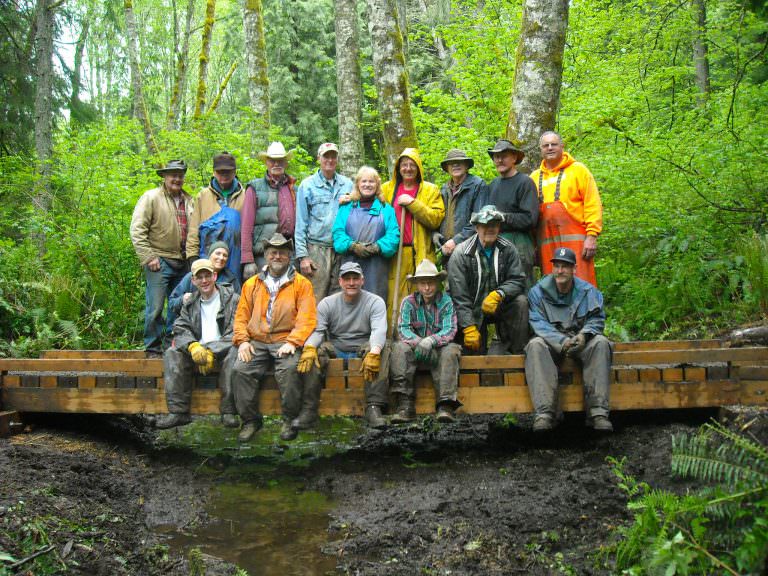Cleaning your saddle pad
Cleaning your saddle pad
Saddle pads get dirty, really dirty, really quickly. Sweat and dirt happen when we ride and it’s up to us to stay on top of the filth lest our mounts suffer. It’s time to clean our saddle pad.
I’m not about to say that I wash my pads after every ride. What I do is let them dry between rides (I have three pads that I alternate using) and prior to the following use I gently brush them in a circlular motion, with a rubber curry to break up any dried grime and sweat chunks.
But, by the end of summer those pads have seen a lot of trail miles pass under them and it’s time for a more thorough cleaning to remove the more stubborn deposits.
My fabulous first idea was to put the pads in the washing machine. My much better half said that wasn’t going to happen and that I should find a better alternative. Being too lazy to visit the local laundry mat I opted for a fence gate and a hose.
I use Skito saddle pads that have laminated foam shims inside a fleece pocket, so my cleaning process may be slightly more involved.
1 – Remove the foam inserts and let them soak in a bucket of cool water. I don’t use any detergent because it’s next to impossible to get out. Any soap residue that remains will irritate my animals and that’s a bad thing. Scientists consider water to be the universal solvent because it’s capable of dissolving more substances than anything else (barring oils which I don’t generally find inside my saddle pad). I use this property to my benefit and simply repeatedly squeezing the foams to slowly work any accumulated salts out of material. Dump and refill the bucket with fresh water as often as you can. I’ve been known to put a small amount of vinegar in the water to help kill any lingering beasties.
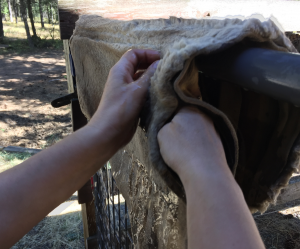 2 – With the saddle pad securely supported, it’s going to be heavy, use a garden use to spray the saddle pad from the inside out. I want to force the grime out of the material not push it further into the fibers. I also try to work from the middle outward, again always trying to push the dirt away from the pad. I’ve found that once the pad is completely saturated with water that rubbing the material with my fingers is easier on the fabric and works better than brushing with curry combs. This phase takes a while and yes, you will be cold and wet, but keep up the good work until the water runs clear.
2 – With the saddle pad securely supported, it’s going to be heavy, use a garden use to spray the saddle pad from the inside out. I want to force the grime out of the material not push it further into the fibers. I also try to work from the middle outward, again always trying to push the dirt away from the pad. I’ve found that once the pad is completely saturated with water that rubbing the material with my fingers is easier on the fabric and works better than brushing with curry combs. This phase takes a while and yes, you will be cold and wet, but keep up the good work until the water runs clear.
3 – Once the pads and the foams cease releasing dirt into your clean water it’s time to dry. Help the pads keep their shape by hanging them over a saddle rack, out of the sun and away from direct heat. Leaving the pad hanging over the gate will cause it to stretch and lose its contoured shape. Direct heat or sun can cause the materials to shrink. Yes, drying this way is slow and takes a while. That’s why we have spare saddle pads.
I wish that I could say that these three steps to a clean saddle pad are a great secret that I discovered. Unfortunately, equipment cleaning is just another part of riding horses and mules. What I have discovered is that by ensuring that when this vital piece of equine tack stays in good working condition it makes for a better ride by continuing to provide the support, protection, and comfort that my animals deserve.
How often do you clean your saddle pads?
For more TrailMeister trail riding tips and thoughts visit www.TrailMeister.com
Keeping Paradise Possible
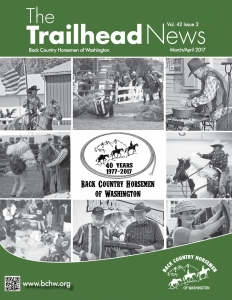 Keeping Paradise Possible – By Robert Eversole – North East Chapter, BCHW
Keeping Paradise Possible – By Robert Eversole – North East Chapter, BCHW
Paradise. For some that’s an image of a tropical beach, for me it’s a dirt trail that twists and meanders to a backcountry camp deep in the wilderness. It’s a quiet solitude punctuated by the peaceful clip clop of hooves and the far scream of an eagle aloft. It’s the sweet perfume of pine on a warm summer day. It’s the
companionship of a trusted horse who will faithfully take you home.
Unfortunately, in a growing number of cases paradise has padlocks.
In only a few short generations we’ve “improved” a lot of backcountry and rural areas into suburbia and shopping malls. Trail Closed signs are both dreaded and unfortunately frequently encountered. Least we lose them, we’d better take care of the equine friendly country that remains. Paradise needs protecting.
You don’t have to be a trail rider, or even have your own horse, to recognize the importance of conserving horse trails. There are many things that each of us can do to preserve equine trails. Unfortunately, often it’s sometimes hard to explain why groups like ours are important. Here are some of the reasons to join that I talk about during my expo clinics.
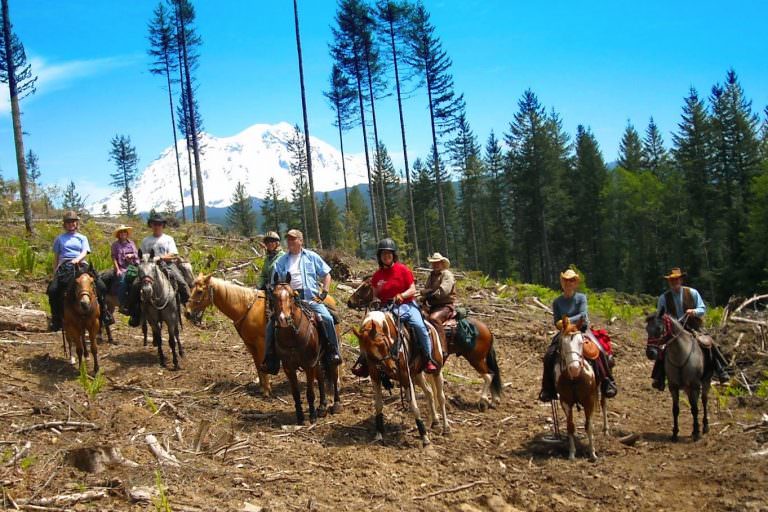 Horse clubs are focal points for both social events and trail stewardship efforts. For me the biggest reason to join an equestrian club is for the comradery of people who have the same interests. Being able to talk about trail conditions, feed, training, etc. is priceless.
Horse clubs are focal points for both social events and trail stewardship efforts. For me the biggest reason to join an equestrian club is for the comradery of people who have the same interests. Being able to talk about trail conditions, feed, training, etc. is priceless.
Don’t have a local Back Country Horsemen group nearby, or don’t care for the one that is? Start a new one. These organizations are always looking for new members and new chapters. A quick google search will put you in touch with someone who can help.
Here are four reasons to join a, or start, a horse club. And quotes from those who have.
- You’ll meet like-minded people and make new friends
“Share activities with like-minded people both socially and out on the trails.”
“The diversity of a club’s membership allows members to ride and camp with others who have similar aspirations and at a whole range of experiences. It makes it easy to find people to ride with when their regular partner is unable to get away.”
“There’s a large group of us who don’t just go out on club rides, we’ll meet up on other weekends too – it’s great to have lots of different people to go riding with.”
“Looking for love? I know lots of couples who met through horses!”
- You’ll see new places and do new things
“You can expand the scope of your own activities by taking part in those organized by more experienced members”
“A lot of clubs have a range of social events which complements the riding scene”
“If you want to go to a new trail area there’s bound to be someone in the club who has already been and willing to give you info on the place”
- You’ll learn new skills
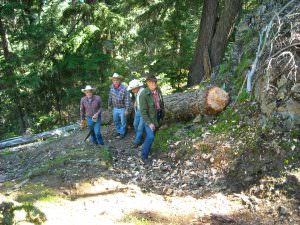 “Many clubs offer training opportunities, however chaotic or informal, and there are always more experienced members around to provide guidance and help.”
“Many clubs offer training opportunities, however chaotic or informal, and there are always more experienced members around to provide guidance and help.”
“Practical peer-to-peer coaching so that we all learn together”
“Knowledge transfer from more experienced members, a bit like an apprenticeship”
“As a new member I doubt that I’d have made the steps to ride outside the arena without the support of the club”
- It’s fun!
“It’s more fun spending your day out with others. And they can get great photos of you and your partner on rides too.”
There are more benefits than just being a member of a club. There are new friends to be made, information to learn and most of all the comradery of people who get what it means to love horses and trail riding.
We live during a time when equine trail use is being curtailed. Most Americans live in urban settings, removed from our version of paradise. Most of them don’t understand the importance of conservation, outdoor recreation, and the protection of trails.
Please, don’t wait until you’re faced with a crisis before you get involved. Volunteer with trail projects, join a club that will help protect your trail access, and educate yourself and others on best practices.
